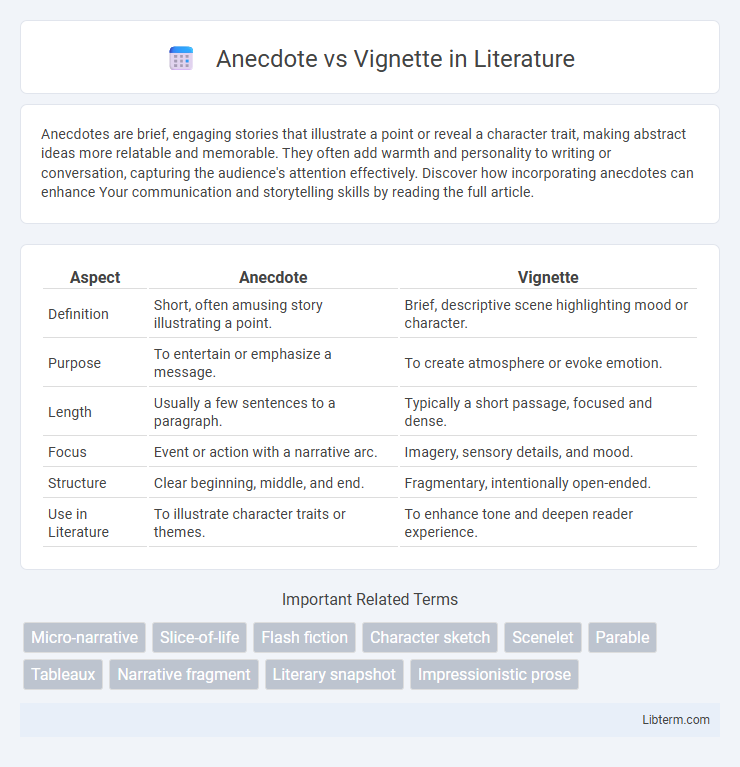Anecdotes are brief, engaging stories that illustrate a point or reveal a character trait, making abstract ideas more relatable and memorable. They often add warmth and personality to writing or conversation, capturing the audience's attention effectively. Discover how incorporating anecdotes can enhance Your communication and storytelling skills by reading the full article.
Table of Comparison
| Aspect | Anecdote | Vignette |
|---|---|---|
| Definition | Short, often amusing story illustrating a point. | Brief, descriptive scene highlighting mood or character. |
| Purpose | To entertain or emphasize a message. | To create atmosphere or evoke emotion. |
| Length | Usually a few sentences to a paragraph. | Typically a short passage, focused and dense. |
| Focus | Event or action with a narrative arc. | Imagery, sensory details, and mood. |
| Structure | Clear beginning, middle, and end. | Fragmentary, intentionally open-ended. |
| Use in Literature | To illustrate character traits or themes. | To enhance tone and deepen reader experience. |
Defining Anecdote: Key Characteristics
An anecdote is a brief, engaging narrative that highlights a specific incident or personal experience, often used to illustrate a point or reveal character traits. Key characteristics include its concise length, a clear focus on one event or moment, and the ability to evoke emotion or insight through storytelling. Unlike vignettes, anecdotes typically have a clear narrative arc with a beginning, middle, and end, emphasizing a single takeaway or lesson.
Understanding Vignette: Essential Features
A vignette is a brief, evocative description or story that captures a specific moment, character, or idea, emphasizing mood and atmosphere rather than plot. Unlike anecdotes, which are concise narratives centered around a particular event or lesson, vignettes prioritize sensory detail and emotional tone to provide insight or create a vivid impression. Key features of vignettes include brevity, vivid imagery, and a focus on character or setting without a traditional narrative structure.
Historical Origins of Anecdotes and Vignettes
Anecdotes trace their origins to ancient Greece and Rome, where they were primarily used by historians like Plutarch to illustrate character traits through brief, engaging stories. Vignettes emerged in 19th-century literature and visual arts as short, descriptive sketches designed to capture mood or scene rather than convey a complete narrative. Both forms evolved to serve distinct purposes: anecdotes emphasize personal experience or moral lessons, while vignettes focus on atmospheric detail and impressionistic snapshots.
Purpose and Function in Storytelling
Anecdotes serve as brief, engaging stories that illustrate a specific point or theme, often highlighting character traits or moral lessons in storytelling. Vignettes provide atmospheric snapshots or scenes that focus on mood, setting, or character moments without necessarily advancing the plot. Both enhance narrative depth, with anecdotes emphasizing meaningful incidents and vignettes creating immersive emotional or sensory experiences.
Structural Differences: Anecdote vs Vignette
An anecdote typically features a concise, complete narrative with a clear beginning, middle, and end, often highlighting a specific event or lesson. In contrast, a vignette presents a brief, impressionistic scene or moment without a structured plot or resolution, focusing more on mood or character insight. The anecdote's structure aims to convey a point or humor, whereas the vignette emphasizes atmosphere and sensory detail.
Emotional Impact and Reader Engagement
Anecdotes create emotional impact by sharing brief, personal stories that foster connection through relatable experiences and vivid details. Vignettes engage readers by offering concise, evocative scenes that emphasize mood and atmosphere, allowing for deeper emotional resonance without extensive narrative. Both techniques enhance reader engagement by appealing to empathy and imagination in distinct but complementary ways.
Common Uses in Literature and Media
Anecdotes are commonly used in literature and media to provide brief, illustrative stories that highlight a particular point or theme, often enhancing character development or thematic depth. Vignettes serve as compact, evocative scenes that capture a moment, mood, or character insight, frequently employed in novels, short story collections, and films to create atmospheric emphasis or explore subjective experiences. Both techniques enrich narrative texture, with anecdotes emphasizing narrative clarity and vignettes prioritizing sensory or emotional resonance.
Examples of Anecdotes in Writing
Anecdotes in writing are brief, engaging stories that illustrate a point or reveal character traits, such as Mark Twain's humorous tale about his childhood adventures or Maya Angelou's recounting of a defining moment in her youth. These vivid narrations provide personal insight and emotional connection while remaining concise and relevant to the topic. Anecdotes differ from vignettes by their clear narrative arc and purpose in supporting the author's argument or theme.
Examples of Vignettes in Literature
Vignettes in literature often serve as brief, evocative scenes that capture a character's mood, setting, or moment without developing a full plot, unlike anecdotes which narrate complete incidents. Examples include the delicate, impressionistic snapshots in Ray Bradbury's "Dandelion Wine," where each vignette paints a slice of summer memory, and the poignant, character-driven glimpses found in Sandra Cisneros' "The House on Mango Street," revealing the cultural and emotional landscape of the protagonist. These literary vignettes provide depth through rich imagery and focused detail, enhancing the reader's immersive experience.
Choosing Between Anecdote and Vignette
Choosing between an anecdote and a vignette depends on the purpose and depth of the narrative needed. Anecdotes are brief, personal stories that illustrate a specific point or highlight a particular event, making them ideal for engaging readers with relatable experiences. Vignettes offer a more detailed, evocative snapshot of a scene or character, providing atmospheric insight without the necessity of a full storyline.
Anecdote Infographic

 libterm.com
libterm.com